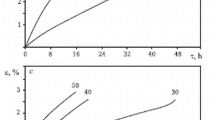Abstract
The effects of pores and low-melting phases on the creep in multiphase oxide ceramics are analyzed using experimental data. It is shown that the high stress level produced by pores has no effect on the creep behavior of the ceramics. The pores reduce the contact cross section, which is smaller than the effective cross section taking into account only the pore area. The deformation of the skeleton is determined by the content and viscosity of the low-melting phase, whose composition and distribution depend on the content of impurities. The grains of the refractory phase increase the effective viscosity of the material.
Similar content being viewed by others
REFERENCES
Bakunov, V.S. and Belyakov, A.V., Analyzing the Structure of Ceramics, Neorg. Mater., 1996, vol. 32, no. 2, pp. 243–248 [Inorg. Mater. (Engl. Transl.), vol. 32, no. 2, pp. 220-223].
Bakunov, V.S., High-Temperature Creep in Refractory Ceramics: Driving Forces and Mechanisms, Ogneupory, 1994, no. 7, pp. 12–17.
Bakunov, V.S. and Belyakov, A.V., Diffusional Creep in Oxide Ceramics and Point Defects, Neorg. Mater. (in press).
Bakunov, V.S. and Belyakov, A.V., Effect of Grain Boundaries on the Diffusional Creep in Oxide Ceramics, Neorg. Mater. (in press).
Chebotin, V.N., Fizicheskaya khimiya tverdogo tela (Physical Chemistry of Solids), Moscow: Khimiya, 1982.
Kovtunenko, P.V., Fizicheskaya khimiya tverdogo tela. Kristally s defektami (Physical Chemistry of Solids: Imperfect Crystals), Moscow: Vysshaya Shkola, 1993.
Prochnost' materialov pri vysokikh temperaturakh (High-Temperature Strength of Materials), Pisarenko, G.S. et al., Eds., Kiev: Naukova Dumka, 1966.
Bal'shin, M.Yu., Contact Cross Section of Powder Compacts and Sintered Bodies and Significance of Their Mechanical Properties Reduced to Unit Contact Cross-Sectional Area, Poroshk. Metall. (Kiev), 1963, no. 4, pp. 29–33.
Adushkin, L.E., Bakunov, V.S., Poluboyarinov, D.N., and Guzman, I.Ya., Strength and Deformation of Oxide Ceramics, Izv. Akad. Nauk SSSR, Neorg. Mater., 1970, vol. 6, no. 7, pp. 753–760.
Bakunov, V.S., High-Temperature Creep in Refractory Ceramics: Porous Materials, Ogneupory, 1994, no. 10, pp. 2–6.
Borovkova, L.B., Lukin, E.S., Poluboyarinov, D.N., and Bakunov, V.S., Creep in Yttria-Based Ceramics, Izv. Akad. Nauk SSSR, Neorg. Mater., 1974, vol. 10, no. 5, pp. 29–31.
Sokolova, L.V. and Bakunov, V.S., Creep in Alumina Materials, Steklo Keram., 1983, no. 5, pp. 18–20.
Bakunov, High-Temperature Creep in Refractory Ceramics, Ogneupory, 1994, no. 11, pp. 2–8.
Borovkova, L.B., Lukin, E.S., and Poluboyarinov, D.N., Creep in Aluminosilicate Refractories, Ogneupory, 1969, no. 7, pp. 39–42.
Author information
Authors and Affiliations
Rights and permissions
About this article
Cite this article
Bakunov, V.S., Belyakov, A.V. Creep and Structure of Ceramics. Inorganic Materials 36, 1297–1301 (2000). https://doi.org/10.1023/A:1026658404494
Issue Date:
DOI: https://doi.org/10.1023/A:1026658404494




